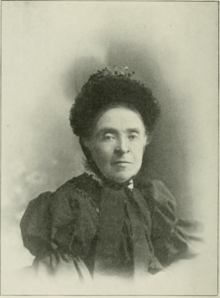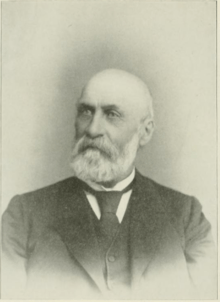Sara Tappan Doolittle Robinson
Sara Tappan Doolittle Robinson (née Lawrence) (July 12, 1827 – November 15, 1912) was a US writer and historian.[1] She served as Kansas' First Lady, 1861–1863, being the second wife of Charles L. Robinson (1818–1894), the first Governor of Kansas. Robinson is most notable for her book, Kansas : its interior and exterior life ; including a full view of its settlement, political history, social life, climate soil, productions, scenery, etc. (1856) during which time, her house was plundered and burned. The book was considered "epoch making" for its time.[2]

Early years
She was born in Belchertown, Massachusetts.[3] She was the eldest daughter of Myron and Clarissa (Dwight) Lawrence. The distinguished people of the times visited the family home. Among the most noted were Daniel Webster, Harriet Martineau, Stephen Olin, Robert Rantoul, George Ashmun and W. B. Calhoun.

She attended school in Belchertown and also studied at the New Salem Academy. While attending school, she fell and injured her spine, which led to sympathetic blindness. Dr. Robinson (later Governor) was practicing medicine in Belchertown, where he was introduced to Miss Lawrence. Under his care, she regained her health. They married on October 30, 1851.[4]
Biography
Robinson was member of the Betty Washington Chapter of the Daughters of the American Revolution. She founded a research table in the Marine Biological Laboratory at Woods Hole, Massachusetts for young women. She gave the first donation toward marking the Santa Fe Trail. The Robinsons did not have any children. She had been with the Sunflower State from its inception, and died in Lawrence, Kansas at the couple's "Oakridge" home in 1911. Their estate, valued at $200,000, was bequeathed to the University of Kansas.[2] The couple's private papers, 1834–1911, are part of the holdings of the Kansas State Historical Society.[5]
Partial works
- Kansas; its interior and exterior life. Including a full view of its settlement, political history, social life, climate, soil, productions, scenery, etc. (1856)
- Personal recollections of Mrs. Sara T.D. Robinson of the Quantrell Raid of Aug. 21, 1863. (between 1863 and 1911)
References
- Herman, Kali (1984). Women in particular: an index to American women. Oryx Press. p. 193. ISBN 978-0-89774-088-3. Retrieved 21 February 2012.
- Daughters of the American Revolution (1912). Daughters of the American Revolution magazine (Public domain ed.). National Society of the Daughters of the American Revolution. pp. 35–. Retrieved 21 February 2012.
- Wilson, James Grant; Fiske, John (1888). Appleton's cyclopædia of American biography (Public domain ed.). D. Appleton and Company. pp. 283–. Retrieved 21 February 2012.
- Blackmar, Frank Wilson (1912). Kansas: a cyclopedia of state history, embracing events, institutions, industries, counties, cities, towns, prominent persons, etc. ... with a supplementary volume devoted to selected personal history and reminiscence (Public domain ed.). Standard publishing company. pp. 24–. Retrieved 21 February 2012.
- Robinson, C., Robinson, S. T. L., In Snell, J. W., In Schenck, E. L., Hawley, G. T., Kansas State Historical Society., & United States. (1967). The private papers of Charles and Sara T.D. Robinson, 1834-1911, in the holdings of the Kansas State Historical Society. Topeka: Kansas State Historical Society.